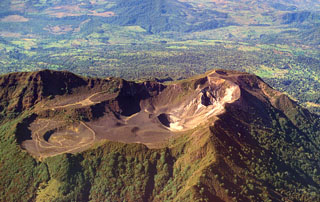Report on Turrialba (Costa Rica) — November 2019
Bulletin of the Global Volcanism Network, vol. 44, no. 11 (November 2019)
Managing Editor: Edward Venzke.
Research and preparation by Paul Berger.
Turrialba (Costa Rica) Activity diminishes during March-October 2019, but small ash emissions continue
Please cite this report as:
Global Volcanism Program, 2019. Report on Turrialba (Costa Rica) (Venzke, E., ed.). Bulletin of the Global Volcanism Network, 44:11. Smithsonian Institution. https://doi.org/10.5479/si.GVP.BGVN201911-345070
Turrialba
Costa Rica
10.025°N, 83.767°W; summit elev. 3340 m
All times are local (unless otherwise noted)
This report summarizes activity at Turrialba during March-October 2019. Typical activity similar to that reported in late 2018 and early 2019 (BGVN 44:04) included periodic weak ash explosions and numerous emissions containing some ash. However, during this period activity appeared to diminish with time. Data were provided by weekly reports by the Observatorio Vulcanologico Sismologica de Costa Rica-Universidad Nacional (OVSICORI-UNA).
According to OVSICORI-UNA, only highly diluted ash emissions were recorded from 22 April to 27 May (note that no reports were available online from the last week of March until 22 April). Weak ash explosions were again noted on 28 July, 4 August, and possibly on 20 October. OVSICORI-UNA reported more explosions or emissions containing ash on 25 and 28 October (table 9).
Table 9. Summary of reported activity at Turrialba, March-October 2019. Cloudy weather sometimes obscured observations. Maximum plume height is above the crater rim. Information courtesy of OVSICORI-UNA.
| Date | Time | Max plume height | Plume drift | Remarks |
| 01 Mar 2019 | 0444 | 200 m | NE | -- |
| 02-04 Mar 2019 | -- | 200-300 m | -- | Continuous emissions with minor amounts of ash. |
| 09-12 Mar 2019 | -- | 1,000 m | -- | Gas plumes containing minor amounts of ash. |
| 16-17 Mar 2019 | -- | -- | -- | Frequent and discontinuous emissions, but no visual confirmation due to poor visibility. |
| 20-22 Mar 2019 | -- | 300 m | W, SW | Continuous emissions of steam with periodic pulses of diffuse ash; sulfur odor noted in Tierra Blanca de Cartago on 22 March. |
| 23-26 Mar 2019 | -- | -- | -- | Steam plumes with low concentration of magmatic gases. |
| 24 Mar 2019 | 0503 | 500 m | -- | Series of four pulses with ash. |
| 31 Mar 2019 | 0735 | -- | -- | Explosion followed by passive emissions with low concentration of magmatic gases. Seismicity dominated by low-frequency events. |
| 08 Apr 2019 | -- | -- | -- | Minor ash emissions. |
| 24 Apr 2019 | -- | -- | -- | Diffuse ash emission. |
| 26 Apr 2019 | -- | -- | N | Emission with low ash content. |
| 27 Apr 2019 | 0722 | below 100 m | -- | Weak, brief explosion with ash plume. |
| 04 May 2019 | 0524 | -- | -- | Emission of very diluted ash. |
| 12-19 May 2019 | -- | -- | -- | Passive, short-duration emissions with small amounts of ash occurred sporadically. |
| 19-20 May 2019 | -- | -- | -- | Prolonged and intermittent periods of emissions with minor amounts of ash. |
| 28 Jul 2019 | 1441 | -- | -- | Weak explosion and ash emission after 30 minutes of heavy rain. Inclement weather prevented visual confirmation. Ashfall in La Picada (N) and El Retiro farms. |
| 03-04 Aug 2019 | -- | -- | -- | Two small explosions, with some ash in the second. |
| 11 Aug 2019 | -- | -- | -- | Weak emission during night, identified by its seismic signal. No ash emission observed. |
| 05 Aug-19 Oct 2019 | -- | -- | -- | No ash detected. |
| 20 Oct 2019 | 2100 | -- | -- | Explosion identified with seismicity; weather conditions prevented visual observation. No ashfall reported. |
| 25 Oct 2019 | 0400, 0700 | -- | -- | Weak explosion at 0400, with ash. Ash at 0700 not associated with seismic signal, so could be a small intra-crater collapse. |
| 28 Oct 2019 | 1500 | -- | -- | Weak emission containing ash. |
A report from Red Sismologica Nacional (RSN) about the 28 October ash explosion noted that it occurred at 1501 local time and lasted about 5 minutes. There were no reports of ashfall, but the crater webcam captured the small plume rising from the active vent. Incandescence in the active crater continued to be seen on the monitoring cameras.
Geological Summary. Turrialba, the easternmost of Costa Rica's Holocene volcanoes, is a large vegetated basaltic-to-dacitic stratovolcano located across a broad saddle NE of Irazú volcano overlooking the city of Cartago. The massive edifice covers an area of 500 km2. Three well-defined craters occur at the upper SW end of a broad 800 x 2200 m summit depression that is breached to the NE. Most activity originated from the summit vent complex, but two pyroclastic cones are located on the SW flank. Five major explosive eruptions have occurred during the past 3500 years. A series of explosive eruptions during the 19th century were sometimes accompanied by pyroclastic flows. Fumarolic activity continues at the central and SW summit craters.
Information Contacts: Observatorio Vulcanologico Sismologica de Costa Rica-Universidad Nacional (OVSICORI-UNA), Apartado 86-3000, Heredia, Costa Rica (URL: http://www.ovsicori.una.ac.cr/); Red Sismologica Nacional (RSN) a collaboration between a) the Sección de Sismología, Vulcanología y Exploración Geofísica de la Escuela Centroamericana de Geología de la Universidad de Costa Rica (UCR), and b) the Área de Amenazas y Auscultación Sismológica y Volcánica del Instituto Costarricense de Electricidad (ICE), Costa Rica (URL: https://rsn.ucr.ac.cr/).

